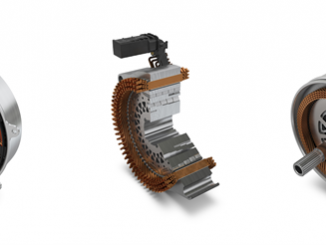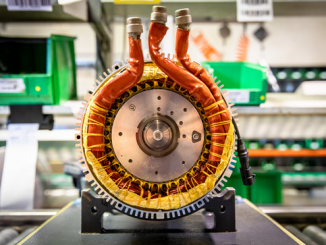
Note from the Editor: It is widely accepted that Increasing the density of data storage is crucial to the future of inexpensive digital technology. Since magnetic hard-disk drives are the dominant storage medium for the Cloud, for years the continued evolution of this $30 billion industry has been seen to depend on the commercial development of heat-assisted magnetic recording (HAMR). This technology uses heat from a laser beam confined well below the diffraction limit to write to media near 450C with high magnetic anisotropy that would normally be unwritable under available magnetic fields. Under the hood, hard drive media rely on ultra-thin coatings of iron oxide, a ferromagnetic material which can be permanently magnetized when exposed to a magnetic field. Each drive head has a tiny electromagnet consisting of an iron core wrapped in wire. Ironically, high temperature is typically the enemy of magnetics performance but, in this case, it is the enabler.
Achieving another major milestone toward volume shipments of its pioneering HAMR (heat-assisted magnetic recording) technology, Seagate announced it has used its advanced HAMR technology to build and test the worlds first formatted and fully functioning 16TB enterprise hard drive platform in a standard 3.5-inch form factor the highest capacity hard drives ever produced. Seagate is on track to grow beyond 20TB per drive in calendar 2020.
Seagate is using this 16 terabyte pre-release version of its HAMR-based Exos hard drive to run the tests customers commonly use when integrating hard drives into enterprise applications. The successful tests have confirmed the HAMR drives are plug-and-play and operate just as any other hard drive in standard enterprise application environments, the company said. No architectural changes are needed to integrate HAMR drives into current data centers and systems. Customers simply plug the drives in as with any other enterprise hard drive.
In todays dawning Data Age, the hunger for greater storage capacity continues to accelerate, as data capture and creation at the edge proliferates, and rapidly-evolving Artificial Intelligence applications demand access to ever-larger datasets to extract crucial learnings. Affordable, deployable storage capacity enables the digitization of the world. Seagate has developed HAMR to enable the next big increase in the amount of data that can be stored on a hard drive.
HAMR uses a new kind of media magnetic technology on each disk that allows data bits, or grains, to become smaller and more densely packed than ever, while remaining magnetically stable. A small laser diode attached to each recording head heats a tiny spot on the disk, which enables the recording head to flip the magnetic polarity of each very stable bit, enabling data to be written. Seagates proprietary execution of HAMR technology will be delivered in the industrys standard form factor, thus reducing total cost of ownership by getting a lot more terabytes into the same space as a conventional hard drive.

Jason Feist
Seagate has begun running early Exos HAMR units through the full set of standard benchmark tests used to prepare and optimize each new hard drive product for deployment, says Jason Feist, Seagates senior director of enterprise product line management. Our testing has demonstrated the drives compatibility for enterprise systems that are being used today. No system level changes are needed to run the HAMR drives in these evaluations, or to deploy them in customer environments.

The Exos HAMR drives run like all other drives in a standard suite of integration benchmarks. At this point in early testing, theyre meeting our expectations for how a drive should interact in each benchmark, Feist explains. These are the same tests that customers use to qualify every new drive, including power efficiency, utilities that test commands to devices and others, said Geist.
These new product-level HAMR tests provide further weight to the groundbreaking results from last years in-lab reliability tests. In those tests Seagate HAMR read/write heads far exceeded industry standards for reliability and lifetime data transfer capability, surpassing customer requirements and standard hard drive specifications by a factor of 20. Combined with HAMRs plug-and-play compatibility with standard systems, the results have further cemented customers confidence in HAMRs readiness to launch into standard cloud and IT environments, he said.
The HAMR technology we demoed last year is now being fully integrated into Seagates high-capacity enterprise product portfolio, says Feist. We continue on track to deliver the future generations of Seagate Exos hard drives equipped with HAMR to achieve industry-leading areal density and capacity.
For more information, visit: https://www.seagate.com/



